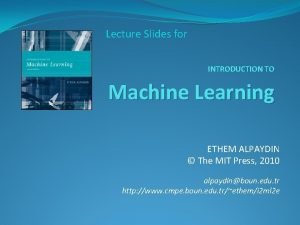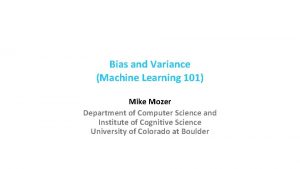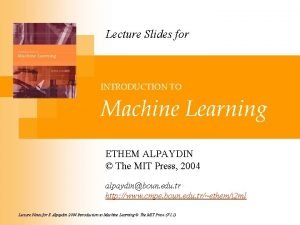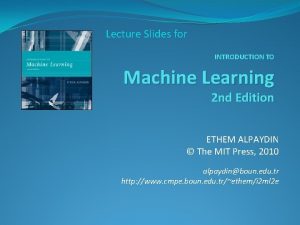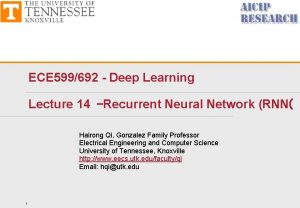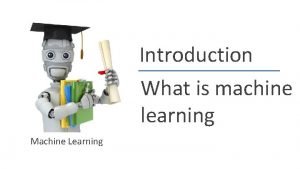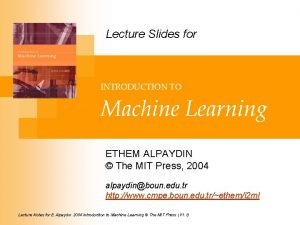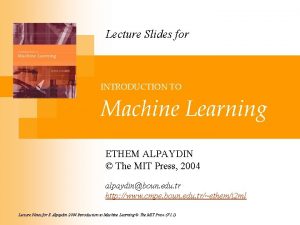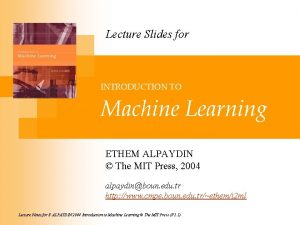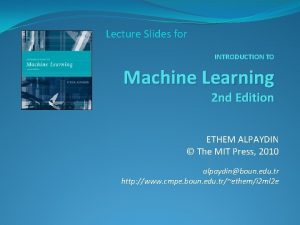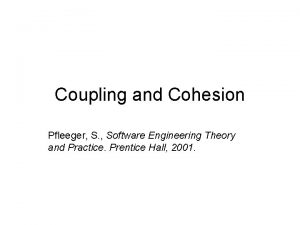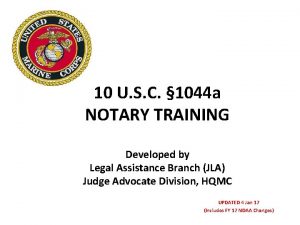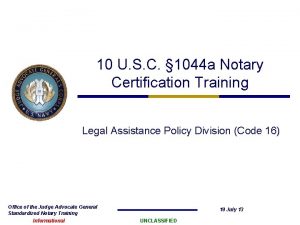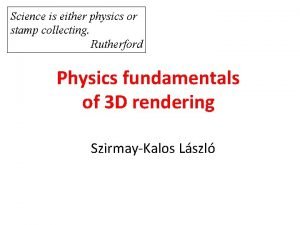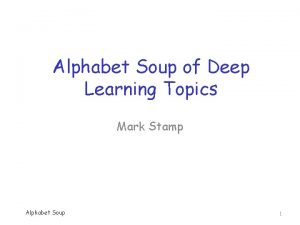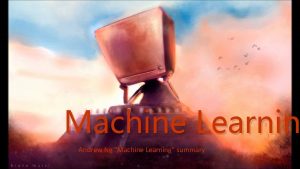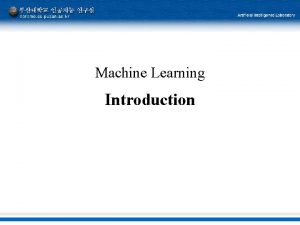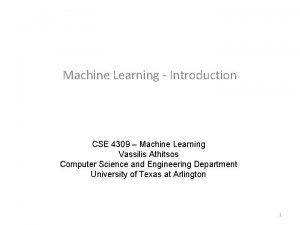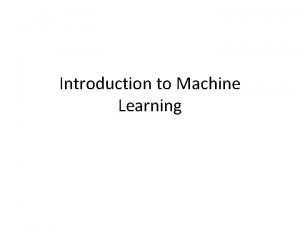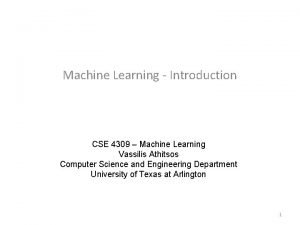Intro to Machine Learning Mark Stamp Introduction to








































- Slides: 40

Intro to Machine Learning Mark Stamp Introduction to Machine Learning 1

What is Machine Learning? q Definition of machine learning (ML)? o Our working definition is… o Statistical discrimination, where the “machine” does the hard work of “learning” o So, we humans don’t have to think too much q Often associated with AI o But actually much more widely applicable q Often, based on a binary classifier o Multiclass problems also of interest q ML said to generate “data driven” models Introduction to Machine Learning 2

What Can ML Do for Me? q Machine learning is very powerful o Practical and useful q Successfully applied to problems in… o Speech recognition and NLP, bioinformatics, stock market analysis, AI (robotics, computer vision, etc. ), malware, spam detection, autonomous vehicles, … o More and more applications all the time o Limited only by your imagination Introduction to Machine Learning 3

Black Box Approach q Machine learning (ML) algorithm often treated as a black box o This is one of ML’s main selling points! q ML black box view often works well o Can get good results even if you know nothing about underlying algorithms q But, black box approach is limiting o Especially in new and novel applications Introduction to Machine Learning 4

Analogy to a Doctor q Nurse practitioner (NP) is a nurse with advanced training o Physician has much more education o Like medical doctor, an NP can diagnose, treat, and manage patients’ problems q Studies show that NPs can do about 80% to 90% of what physicians do o But for the most challenging 10% to 20% of cases, a physician is required Introduction to Machine Learning 5

Interesting, But What Does This Have to Do with ML? q ML version of NP would have knowledge beyond black box, but not too much q ML version of physician would really understand how/why things work q Goal is for you to become ML physician q For doctors, most challenging 10% to 20% of cases are most interesting… o …and the most lucrative! Introduction to Machine Learning 6

Auto Mechanic Analogy q The majority of diagnosis work done by auto mechanics is routine o Often easy to see what the problem is (not necessarily easy to fix, though!) q But, there are some difficult cases o Where no “cookbook” diagnosis will work o Skill needed to analyze such problems o Requires deep understanding of inner workings of engine and related systems Introduction to Machine Learning 7

ML from 10, 000 Feet q We focus on binary classification o Data of “type A” and “not type A” q First, we train a model on “type A” q Then given sample of unknown type o Score the sample against the model o If it scores high, classify it as “type A” o Otherwise, classify it as “not type A” q Key ideas are training and scoring Introduction to Machine Learning 8

“Classic” ML Topics Hidden Markov Model (HMM) q Profile Hidden Markov Model (PHMM) q Principal Component Analysis (PCA) q o And Singular Value Decomposition (SVD) Support Vector Machine (SVM) q Clustering (emphasis on K-means and EM) q Neural networks (ANN) q o Backpropagation, different types (MLP, CNN, …) q Data analysis Introduction to Machine Learning 9

Many Mini-Topics q Topics on previous slide covered in great detail q Additional “classic” techniques covered in less detail… o o k-nearest neighbor (k-NN) Boosting (Ada. Boost) Random Forests (RF) Linear Discriminant Analysis (LDA) Introduction to Machine Learning 10

Deep Learning Topics q Backpropagation q Convolutional Neural Network (CNN) q Recurrent Neural Network (RNN) o And Long Short-Term Memory (LSTM) q Residual Network (Res. Net) q Generative Adversarial Network (GAN) q Word 2 Vec, transfer learning, ensemble techniques, ELM, TF-IDF, dropout, etc. Introduction to Machine Learning 11

HMM q We cover HMMs in great(est) detail o More detail than most other techniques o You must implement HMM from scratch o You must really understand HMM! q Compare/contrast most things to HMM q HMMs useful in many applications o And models themselves tell us something o Not always true of other algorithms Introduction to Machine Learning 12

High Level View of HMM q Markov process, where states “hidden” q Observations related to hidden states Introduction to Machine Learning 13

HMM as Hill Climb q Hill climb on parameter space q What is a hill climb? o Only go “up”, never “down” o In contrast to heuristic search, such as genetic algorithm or simulated annealing q Advantage(s) of hill climb algorithm? q Disadvantages/limitations of hill climb q Alternatives to hill climb? Introduction to Machine Learning 14

PHMM q Like HMM with positional information q Conceptually appealing o Details tend to be very problem specific q Widely used in bioinformatics o And other applications where position within sequence is critical information q Has been used successfully in security research (IDS, malware detection) Introduction to Machine Learning 15

High Level View of PHMM q Like defining a (particularly simple) HMM at each position in sequence o Easier to understand once we study HMM Introduction to Machine Learning 16

PCA q PCA serves to reduce dimensionality q Training is complex (linear algebra) o But scoring is fast and efficient o So, when the dust settles, PCA is actually easy to use and very efficient q Singular Value Decomposition (SVD) (almost) synonymous with PCA o SVD is one way to train a model in PCA Introduction to Machine Learning 17

High Level View of PCA q Find directions with highest variance o Reveals useful info… o …dimensionality can be reduced o Why high variance? q Need some linear algebra here… Introduction to Machine Learning 18

SVM q SVM has nice geometric interpretation o We can draw pretty pictures! q In SVM, we increase the dimension o May be counterintuitive (compare to PCA) q SVM often used similar to other ML o But also ideal as a “meta-score” to combine other scores/techniques q Nice combination of theory & practice Introduction to Machine Learning 19

High Level View of SVM q Labeled training data o Separate the sets… o …and maximize “margin” q Easy to picture o We use lots of calculus to make sense of SVM o Derivation of SVM is not trivial! Introduction to Machine Learning 20

Clustering q Usually, used for “data exploration” o I. e. , we cluster hoping to learn structure from data that we know little about o Observed structure may or may not be meaningful (we can cluster anything) q In detail, we consider o K-means clustering o EM (expectation maximization) clustering Introduction to Machine Learning 21

Clustering Example q Unsupervised o Data exploration q K-means is easy and intuitive q EM more challenging o Some statistics… o Multivariate Gaussian distributions! Introduction to Machine Learning 22

Classic Mini Topics++ q Boosting o Make arbitrarily strong classifier from many (weak) classifiers o Focus on Ada. Boost (Adaptive Boosting), which is simplest strategy q Linear Discriminant Analysis (LDA) o Discuss this in some detail o Interesting connections to PCA and SVM Introduction to Machine Learning 23

Classic Mini Topics q Random forest (RF) o Very popular and useful o Based on decision trees o We cover only the very basics q K-nearest neighbor (k-NN) o Simplest “machine learning” imaginable o Often works surprisingly well Introduction to Machine Learning 24

Deep Learning Topics q Artificial neural network (ANN) o A mini-topic in the book o But now major-topic of the course q Backpropagation o Technique to train most neural networks o Essentially, a BIG calculus problem o Based on automatic differentiation and… o Reverse mode automatic differenatiation Introduction to Machine Learning 25

MLP q Multilayer Perceptron q Basic type of neural network q Feedforward network o There are no loops or feedback Introduction to Machine Learning 26

CNN q Convolutional neural network q Optimized for image analysis q Convolutions for translation invariance and efficient training q CNNs are popular Introduction to Machine Learning 27

RNN and LSTM q Vanilla networks are feedforward o Have no “memory” q RNN has memory q Problem with RNN o Vanishing gradient q LSTM is improved form of RNN Introduction to Machine Learning 28

Res. Net q Residual network also deal with vanishing gradient q Shortcuts for “improved” gradient Introduction to Machine Learning 29

GAN q Discriminative network (D) classifies q Generative network (G) generates (fake) samples that fit training data q Generative adversarial network (GAN) pits D and G against each other o D trained to distinguish between real samples and fake data from G o G trained to trick D network o D and G compete in a “minimax” game q Both D and G can improve in training Introduction to Machine Learning 30

GAN q GAN algorithm is surprisingly simple Introduction to Machine Learning 31

Word 2 Vec q Vector “embeddings” of words q Word 2 Vec uses shallow neural network o Train neural network on words o Weights of trained network are the embedding vectors o Model not used for any other purpose q Word 2 Vec algebraic properties captures “meaning” of langauge Introduction to Machine Learning 32

Deep Learning Mini Topics q Transfer learning q Ensemble techniques o Use pre-trained model o Re-train the output layer o Combine multiple techniques o Ensembles win most competitions q Dropout and regularization o Ways to avoid overfitting o “Learning” vs “memorization” q And more… Introduction to Machine Learning 33

The Dreaded Math/Stats q We strive to keep math to a minimum o Course is (mostly) self-contained wrt math o We do assume knowledge of calculus q To o o understand ML, cannot avoid math. . . HMM/PHMM discrete probability PCA fancy linear algebra (eigenvectors) SVM calculus (Lagrange multipliers) Clustering statistics/probability Backpropagation calculus (computational) Introduction to Machine Learning 34

Data Analysis q Critical to analyze data carefully q Especially true in research mode, as we must compare to previous work q Often, a major weakness! q We’ll discuss… o Experimental design, cross validation, accuracy, ROC curves, PR curves, imbalance problem, and so on Introduction to Machine Learning 35

Applications q Applications mostly from security o Malware detection or analysis HMM, PCA, SVM, CNN, and clustering o Masquerade detection PHMM o Image spam PCA and SVM o Classic cryptanalysis HMM o Facial recognition PCA o Text analysis HMM o Old Faithful geyser clustering Introduction to Machine Learning 36

3 Stages to ML Enlightenment q First stage elementary-school level o “Big picture” from 10 k feet o See the descriptions in this intro q Second stage drill down on big picture o More detailed and nuanced than first stage o Understand the pictures used in stage 1 q Third stage deep understanding o Learn derivations and (mostly) understand Introduction to Machine Learning 37

ML Enlightenment q In this class, we aim for highest stage of ML enlightenment o To pass the class, at a minimum, you must have stage 2++ knowledge… o … and ability to effectively use ML … o … and understand strengths/weaknesses q Key to success o Work hard on homework and project! Introduction to Machine Learning 38

Bottom Line q We cover selected machine learning techniques in considerable detail q We discuss many applications, mostly related to information security q Goal is for students to gain a deep understanding of the techniques o And be able to apply ML… o …especially in new and novel situations Introduction to Machine Learning 39

How to Succeed in ML Class q Ask questions o Good questions are good for everybody q Treat the math as your friend o Math is necessary to make sense of ML q Do not fear hard work! o Machine learning is not a spectator sport q Learning is a 3 step process o Read book, attend lecture, do homework Introduction to Machine Learning 40
 Andrew ng intro machine learning
Andrew ng intro machine learning Introduction to machine learning andrew ng
Introduction to machine learning andrew ng Concept learning task in machine learning
Concept learning task in machine learning Analytical learning in machine learning
Analytical learning in machine learning Pac learning model in machine learning
Pac learning model in machine learning Machine learning t mitchell
Machine learning t mitchell Inductive and analytical learning in machine learning
Inductive and analytical learning in machine learning Analytical learning vs inductive learning
Analytical learning vs inductive learning Instance based learning in machine learning
Instance based learning in machine learning Inductive learning machine learning
Inductive learning machine learning First order rule learning in machine learning
First order rule learning in machine learning Difference between lazy learner and eager learner
Difference between lazy learner and eager learner Deep learning vs machine learning
Deep learning vs machine learning Introduction to machine learning ethem alpaydin
Introduction to machine learning ethem alpaydin High bias low variance introduction to machine learning
High bias low variance introduction to machine learning Introduction to machine learning ethem alpaydin
Introduction to machine learning ethem alpaydin Andrew ng machine learning slides
Andrew ng machine learning slides Introduction to machine learning slides
Introduction to machine learning slides Data mining azure
Data mining azure A friendly introduction to machine learning
A friendly introduction to machine learning Introduction to machine learning andrew ng
Introduction to machine learning andrew ng Introduction to machine learning ethem alpaydin
Introduction to machine learning ethem alpaydin Introduction to machine learning ethem alpaydin
Introduction to machine learning ethem alpaydin Machine learning ethem
Machine learning ethem Machine learning lecture notes
Machine learning lecture notes Cuadro comparativo e-learning y b-learning
Cuadro comparativo e-learning y b-learning Shellstock identification tags
Shellstock identification tags Ca stamp format
Ca stamp format Place stamp here
Place stamp here Pan-african movement stamp
Pan-african movement stamp Stamp duty(amendment) proclamation no. 612/2008
Stamp duty(amendment) proclamation no. 612/2008 Migratory bird hunting stamp act
Migratory bird hunting stamp act A round purple inspection stamp of refers to
A round purple inspection stamp of refers to Stamp coupling in software engineering
Stamp coupling in software engineering 10 usc 1044a notary stamp
10 usc 1044a notary stamp 10 usc 1044a notary stamp
10 usc 1044a notary stamp Stamp act
Stamp act App.avantassessment/test
App.avantassessment/test Rutherford stamp collecting
Rutherford stamp collecting Stamp, sort, and distribute mail for an organization
Stamp, sort, and distribute mail for an organization Patch tool photoshop definition
Patch tool photoshop definition













